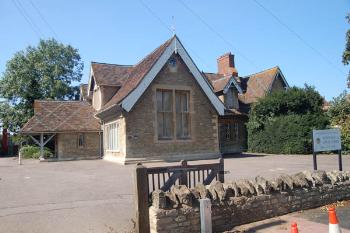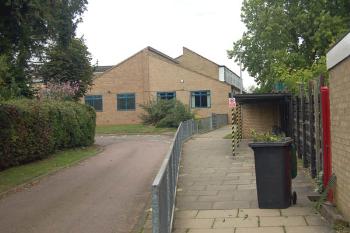Bromham Schools

The former Saint Owen's School August 2007
The first Education Act was passed in 1870 (more correctly it was known as the Elementary Education Act). It was a milestone in the provision of education in Britain demonstrating central government's unequivocal support for education of all classes across the country. It also sought to secularise education by allowing the creation of School Boards. These were groups of representatives, elected by the local ratepayers and the Board had the powers to raise funds to form a local rate to support local education, build and run schools, pay the fees of the poorest children, make local school attendance compulsory between the ages of 5 and 13 and could even support local church schools, though in practice they replaced them, turning them into Board run schools (known as Board Schools). Naturally, and luckily for local historians, the Act required a questionnaire of local schools in 1870. In Bromham the only school existing was "Hon.Miss Rice Trevor's School" which accommodated 144 children and had been built in 1861 by Countess Longford and Miss Rice Trevor. Bromham never formed a School Board and so the school continued to operate as a Free School. Kelly’s Directory described the school as follows: Free School (mixed), built in 1861, with master’s house, at the expense of the Countess of Longford & the Hon. Miss Rice-Trevor, daughter of the late Lord Dynevor, for 120 children; average attendance, 77”.
A charming description of the school is to be found in a newspaper article relating a ramble round Bromham in 1879. In 1885 an Inspector described the school: "The general character and order of the school continue good, and the elementary subjects, including the sewing, are satisfactorily taught" [Micf 28/13].
At this time children were often kept away from school to help at home or on the farm. This is a typical extract from the school logbook, for 18th July 1884: “Many children have been employed by the farmer in pea picking. Average for the week very low” [Micf 28/13]. Nevertheless, Bromham Free School must have had a good name, because in 1888 children from Kempston Rural were being sent there, their fees paid by a charity in that parish.
A land mark Education Act was passed in 1902, coming into effect in 1903. It disbanded the School Boards and gave day to day running of education to newly formed Local Education Authorities, usually the county council, as in Bedfordshire. The old Board Schools thus became Council Schools whilst the old National, British and other non-Board schools became known as Public Elementary Schools. As a former Free School, Bromham became a Public Elementary. Unlike other schools around the county boys and girls continued to be educated in the same school. The school continued to be, essentially, a church school.
![Children at Bromham School about 1900 [X535/3]](/CommunityHistories/Bromham/Bromhamimages/X535-3p24 Bromham School_350x217.jpg)
Children at Bromham School about 1900 [X535/3]
Bedfordshire & Luton Archives & Records Service has a scrapbook of cuttings of visits made to most Bedfordshire Schools by School Inspectors for a period from just before the First World War through the inter-war years [E/IN1/1]. In 1911, when the average attendance was 67, the inspector found "The older scholars are in very good order and the progress which they may is, as a rule, quite satisfactory". The infants, however, were not quite so good, in particular: "The habit of prompting, which is rather prevalent in this division, should be suppressed". Things were looking up in 1913 when: "The School continues to be in good order and to be carefully taught; a creditable level of efficiency is reached in all classes. The Infants are brightly and well taught and general improvement is shown in their work".
The First World War, as in so many walks of life, was detrimental to education, with so many male teachers volunteering for action overseas or, from 1916, being conscripted. When the Inspector visited in 1921, when average attendance was 57, he was only interested in the school garden, reporting as follows: "Even in this difficult year the School Garden has been cultivated with success and isin its usual excellent order. The boys always show interest in their work, and possess considerable knowledge of methods of cultivation, of insect attacks and their prevention, and of weeds and their eradication; they are, too, able to discuss these and similar subjects with intelligence. In short, School gardening in this School is just what School gardening should be". In a still largely agrarian county and society it was very important to fit boys to the sort of life they might expect when they left. This was particularly important in the national consciousness as in 1917, as during the Second World War, Britain was close to starvation due to U Boat attacks on merchant shipping and desperation measures including ploughing up ancient pasture for growing crops were instituted; in such circumstances school gardens became even more important. Only boys did such work girls, of course, undertaking domestic subjects which would fit in with their later lives. By 1926 things in the garden were not so rosy, the Inspector reporting: "The plots are clean and the gardening operations satisfactorily carried out. Boys understand the work and answer fairly well when questioned about it. There is however little practical work beyong vegetable culture, and not much class-room work associated with it; the scope is somewhat narrow for a three-year course".
The visit of 1923 reverted to general education and found the school in "excellent order, and its general condition is very satisfactory indeed". About the only subject to show any weakness was drawing though even this shoiwed "painstaking care". The success achieved was all the more creditable because: "…during May and June there was a closure of three weeks and during three other weeks the attendance was low, through measles". In 1925 the inspector continued to be pelased with progress, drawing now being as good as the other subjects, though singing had fallen off. However the favourable comments "apply to the Bromham children. The children recently transferred here from a neighbouring School were much lower in attainments, but they are receiving every attention, and are steadily improving". The other school was Biddenham which had just been reorganised to teach children under the age of 11 only.
The School House was valued in 1927 under the Rating Valuation Act 1925 [DV1/C3 58]. The valuer found a stone and tile building occupied by John Thomas Grandey and the property comprised a parlour, kitchen and scullery downstairs with three bedrooms above; outside were a washhouse, coal shed, earth closet and big store. Water was provided to a tap and the house included a "nice garden".
The Inspector in 1929 commented that the master (still John Thomas Grandey) was contemplating retirement and that he had "done many years of good work in school and for the village [he was also clerk to the Parish Council]: his wife who has been an assistant to him has also done excellent service. The school is one in which work on old-fashioned lines is conscientiously carried on, examined and criticised. There is little which cannot be praised given these conditions: the weaker children are known and considered: the better children get on well".
By 1934, when average attendance was 55, the school was: …"well conducted…in which steady honest work is found in all subjects. There are one or two somewhat outstanding children; and a few equally marked backward. or retarded, are on the roll". The last report in the scrapbook, for 1938, noted that the good features of the school continued. It noted that there were two classes, the upper of 36 children from 7 to 10 years and the lower of 21 children. Of the elder children it noted: "The work of the brighter children is, indeed, better than it is usual to find in a class of this type". However, of the infants' reading, the inspector remarked: "the teacher should bear in mind the importance of training the children to attack phrases and simple sentences"
The effect of the Second World War on the organisation of the school can be seen in these logbook extracts:
11th September 1939: "School reopened this morning at 9 am. The senior children have been returned from the Kempston Senior School and we have 80 on the registers. There are several small groups of evacuees, besides the larger group of Willesden children with their teachers. Miss Elvie, an evacuee teacher from Oakley has joined the London group. The Bromham Senior Children have been merged into the classes of the London session; in return for which we have 15 junior evacuees – this gives 16 infants and 37 juniors and 15 junior evacuees" [Micf28/13].
18th September 1939 "3 unofficial evacuees have been admitted.’ [Micf28/13] During the war lessons were also disrupted by air raid drills and warnings as well as by frequent re-arranging of the classes.
The third of the great Education Acts was that of 1944 which established the principle of County Primary Schools for children up to the age of 11, at which time they took an examination to determine the nature of the secondary school they would attend until they were 15, the most academically able going to grammar schools, the rest to secondary or secondary modern schools. The act also created two types of successor to the public elementary schools - the Voluntary Aided and Voluntary Controlled schools. Voluntary Aided schools are those in which the Local Education Authority funds the school but the governing body is independent, they are usually Anglican or Roman Catholic schools. Voluntary Controlled schools own their own buildings whilst the staff are employed directly by the governors. Bromham became a Voluntary Controlled County Primary School.
In 1965, a new school was built in Grange Lane specifically for children aged 7 to 11 and became Rice Trevor County Primary Junior School, the old school becoming a school for infants aged 4 to 7 under the name Bromham Voluntary Controlled County Primary Infant School.
In the 1970s Bedfordshire County Council introduced comprehensive education, doing away with the 11+ examination and grammar schools and introducing a tier of school between the old County Primary and County Secondary Schools. Thus Lower Schools now taught children aged 4 to 9, Middle Schools from 9 to 13 and Upper Schools from 13 onwards. Both the schools in Bromham became lower schools - Rice Trevor retained its name whilst the infants school, still in the 1861 buildings, became associated four-square with the local church, being renamed Saint Owen's Lower and retaining its Voluntary Controlled status.
In 1995 the two schools merged as Bromham Church of England Lower School, with both the former school buildings still being used for teaching. The 1861 building is used to teach Early Years and Year 1 children whilst the building in Grange Lane is used to teach children in Years 2, 3 and 4, in effect reverting to the roles from 1965 though as part of one school.
The 1861 school building was listed by English Heritage in August 1987 as Grade II, of special interest. It is described as being built in cottage orné style. It is constructed from, coursed limestone rubble and has a clay tile roof with a large diamond pattern formed by a single line of darker tiles. It forms a T-shape with a school house for the headteacher attached to the north.
Bedfordshire County Council was abolished on 1st April 2009 and the county divided into two unitary councils. The new Local Education Authority for Bromham became Bedford Borough Council.

The former Rice Trevor Lower School September 2007